Urban Form and Function Optimization for Reducing Carbon Emissions Based on Crowd-Sourced Spatio-Temporal Data
Abstract
:1. Introduction
2. Study Area and Data Sources
2.1. Study Area
2.2. Data Sources
2.2.1. POIs Data from Amap
2.2.2. OpenStreetMap Road Network Data
2.2.3. Landsat-8 Remote Sensing Image Data
3. Methods
3.1. Head/Tail Breaks Rule under the Third Geographical Fractal Theory
3.2. Description of Urban Landscape Based on Open-Source Datasets
3.2.1. Identification of Dominant Function with Semantic Association and LSTM Model
3.2.2. Urban Form Description Using Landscape Index
3.3. Spatial Description of Urban CO2 Distribution and Contribution Indices
3.3.1. Spatial Distribution of Urban CO2 Concentration
3.3.2. Description of Spatial Distribution of Urban CO2 Concentration
4. Experiments and Analysis
4.1. Main Plot Division Based on Head/Tail Breaks Rule
4.2. Identification of Main Functional Areas and CO2 Concentration Distribution
4.3. Landscape Index and Its Relationship with CO2 Spatial Concentration
- (1)
- From the perspective of urban form, as seen in the spatial distribution of the LSI index in Figure 9, the urban form is regular in the western region of the study area. In other words, the fractal dimension is low, which verifies the characteristics of heavy “tail” distribution of urban development. The relatively high LSI indices in the eastern part of the study area are a result of the diversity of urban green areas that can be regarded as open spaces. Therefore, it can be seen that the study area has good aesthetic characteristics in urban form design. As the core area of the city, the west of the study area has a wide coverage of public facilities and a low C index. However, in the central part of the study area, the C index is higher because the layout of public facilities is less regular than in other areas.
- (2)
- From the perspective of urban function, most of the SHDI indices in the study area are high, indicating that the overall land use types in the region are diversified. This phenomenon is a result of the western part of the study area being the central business district of Shenzhen, which mainly serves the functions of finance and trade services. It has a large number of amenities such as business offices, hotels, shopping centers, cultural facilities, and high-density public amenities. However, other areas consist mainly of residential, park plazas, and a few commercial functions. Compared to the CBD, they have fewer amenities and therefore have a relatively low Den. It should be noted that there is an orange area in the western part of the study area, which is a relatively independent group with internal facilities that can meet the needs of the residents.
5. The Planning Strategy of Low-Carbon Urban
- (1)
- Optimal morphology: The LSI and C are effective indicators to reflect the urban morphology. The lower these values are, the more regular and stable the urban form is. Therefore, according to the requirements of reducing LSI and C, the industrial layout modes of different business types have been adjusted. Through homogenization and standardization of facility layout, landscape fragmentation in the simulation area is reduced. The lower the mixing degree of regional functions, the more obvious is the improvement of landscape compactness after the regulation. Therefore, this scheme can locally reduce the CO2 concentration and is more suitable for areas with a low functional mixing degree. By reducing LSI by 6.1% and C by 9.4%, the carbon reduction ratio of this scheme is 14.31% (Figure 12b).
- (2)
- Optimal function: SHDI and Den reflect function diversification and spatial agglomeration characteristics, respectively. Therefore, by increasing the low-energy consumption business types and adding public facilities appropriately in the simulation area, SHDI and Den can be increased. Notably, this scheme is suitable for old urban areas that cannot be demolished and built, and which can reduce CO2 concentration globally. In this scheme, LSI is reduced by 16.3% and C is reduced by 12.1%, resulting in a 15.15% carbon reduction ratio (Figure 12c).
- (3)
- Comprehensive development: To achieve the goal of comprehensive development, the morphology and function of the simulation area are regulated and adjusted simultaneously. In this scheme, this is carried out by rebuilding existing buildings and improving infrastructure to adjust LSI, C, SHDI, and den at the same time. It is suitable for new urban districts with unused land or suburban areas, and its CO2 concentration reduction efficiency is the highest, reaching 27.72% (Figure 12d).
6. Conclusions and Discussions
6.1. Conclusions
- (1)
- Based on the unique law of heavy “tail” distribution in urban development, the head/tail breaks method under the third fractal theory came into being. We use this method to divide the evaluation parcels of Futian District and Luohu District, which ensures the integrity of the landscape morphology.
- (2)
- To identify urban functions, semantic association and the LSTM model are integrated. Then, landscape ecological theory is introduced to calculate the landscape index based on POI and OSM data, and this is used to measure the urban morphology. It is found that urban form design is regular and urban land use types are diverse in the study area, and the spatial distribution pattern of urban public service facilities is reasonable, which makes the study area a livable city.
- (3)
- The LST is inversed by Landsat-8 remote sensing data, and the relationship equation between it and the actual CO2 concentration is established to estimate the CO2 concentration in the study area. Then, we quantitatively analyze the contribution of different landscape indices to carbon emissions. The analysis shows that a green space structure with uniform distribution and close connection can give full play to the ecological and social functions of green space. It is considered that the open space structure, with strong accessibility and high density, penetrates into the urban core area to alleviate the negative ecological effects of the city. In addition, at the outer edge of the city, large-scale green space can strengthen its ecological function.
6.2. Discussions
- (1)
- The CO2 concentration cannot completely fit the carbon flux in the region. Hence, it is necessary to explore the relationship between CO2 concentration and carbon flux.
- (2)
- Owing to the different plant types and climates in different regions, the experimental results may be different. Therefore, regional factors need to be considered in future research.
- (3)
- Other factors, such as population distribution and energy consumption demand, may have a significant impact on carbon dioxide emissions. Therefore, social impact factors need to be considered in future research.
Author Contributions
Funding
Acknowledgments
Conflicts of Interest
References
- Liu, M.; Li, P.C. Enlightenment from international programme and development of standardization for climate & carbon neutrality. Stand. Sci. 2020, 12, 121–126. [Google Scholar]
- IPCC Climate Change 2007: The Fourth Assessment Report of the Inter–Governmental Panel on Climate Change; Cambridge University Press: Cambridge, UK, 2007; pp. 103–146.
- McPherson, E.G.; Simpsona, J.R.; Xiao, Q.F.; Wu, C.X. Million trees Los Angeles canopy cover and benefit assessment. Landsc. Urban Plan 2011, 99, 40–50. [Google Scholar] [CrossRef]
- Lu, T.T.; Lane, M.; Van der Horst, D.; Liang, X.; Wu, J.N. Exploring the Impacts of Living in a “Green” City on Individual BMI: A Study of Lingang New Town in Shanghai, China. Int. J. Environ. Res. Public Health 2022, 17, 7105. [Google Scholar] [CrossRef]
- Gao, Z.; Geng, Y.; Wu, R.; Zhang, X.; Pan, H.Y.; Jiang, H.J. China’s CO2 emissions embodied in fixed capital formation and its spatial distribution. Environ. Sci. Pollut. Res. 2020, 27, 19970–19990. [Google Scholar] [CrossRef]
- Luo, M.H.; Qin, S.X.; Chang, H.X.; Zhang, A.Q. Disaggregation Method of Carbon Emission: A Case Study in Wuhan, China. Sustainability 2019, 11, 2093. [Google Scholar] [CrossRef]
- Zheng, X.X.; Wang, R.; He, Q. A City-scale Decomposition and Decoupling Analysis of Carbon Dioxide Emissions: A case study of China. J. Clean. Prod. 2019, 238, 117824. [Google Scholar] [CrossRef]
- Mavromatidis, G.; Orehounig, K.; Richner, P.; Carmeliet, J. A strategy for reducing CO2 emissions from buildings with the Kaya identity—A Swiss energy system analysis and a case study. Energy Policy 2016, 88, 343–354. [Google Scholar] [CrossRef]
- Su, B.; Ang, B.W. Input–output analysis of CO2 emissions embodied in trade: Competitive versus non-competitive imports. Energy Policy 2013, 56, 83–87. [Google Scholar] [CrossRef]
- Xu, S.C.; He, Z.X.; Long, R.Y. Factors that influence carbon emissions due to energy consumption in China: Decomposition analysis using LMDI. Appl. Energy 2014, 127, 182–193. [Google Scholar] [CrossRef]
- Zhou, Y.; Chen, M.X.; Tang, Z.P.; Mei, Z.A. Urbanization, land use change, and carbon emissions: Quantitative assessments for city-level carbon emissions in Beijing-Tianjin-Hebei region. Sustain. Cities Soc. 2021, 66, 102701. [Google Scholar] [CrossRef]
- Xu, Q.; Dong, Y.X.; Yang, R. Urbanization impact on carbon emissions in the Pearl River Delta region: Kuznets curve relationships. J. Clean. Prod. 2018, 180, 514–523. [Google Scholar] [CrossRef]
- Fang, C.L.; Wang, S.J.; Li, G.D. Changing urban forms and carbon dioxide emissions in China: A case study of 30 provincial capital cities. Appl Energy 2015, 158, 519–531. [Google Scholar] [CrossRef]
- Ou, J.P.; Liu, X.P.; Li, X.; Chen, Y.M. Quantifying the relationship between urban forms and carbon emissions using panel data analysis. Landsc. Ecol. 2013, 28, 1889–1907. [Google Scholar] [CrossRef]
- Yang, W.Y.; Li, T.; Cao, X.S. Examining the impacts of socio-economic factors, urban form and transport development on CO2 emissions from transport in China: A panel data analysis of China’s provinces. Habitat Int. 2015, 49, 212–220. [Google Scholar] [CrossRef]
- Lim, S.; Lee, K.T. Implementation of biofuels in Malaysian transportation sector towards sustainable development: A case study of international cooperation between Malaysia and Japan. Renew. Sustain. Energy Rev. 2012, 16, 1790–1800. [Google Scholar] [CrossRef]
- Goodchild, M.F. Citizens as sensors: The world of volunteered geography. GeoJournal 2007, 69, 211–221. [Google Scholar] [CrossRef]
- Mohamed, A.; Najafabadi, M.K.; Wah, Y.B.; Zaman, E.A.K.; Maskat, R. The state of the art and taxonomy of big data analytics: View from new big data framework. Artif. Intell. Rev. 2020, 53, 989–1037. [Google Scholar] [CrossRef]
- Yang, D. Mapping Regional Landscape by Using OpenstreetMap (OSM): A Case Study to Understand Forest Patterns in Maya Zone, Mexico; IGI-Global Press: Hershey, PA, USA, 2017. [Google Scholar]
- Liu, Z. Identifying urban land use social functional parcels: A case study using OSM data. Int. J. Digit. Earth 2021, 14, 1798–1817. [Google Scholar] [CrossRef]
- Niu, H.F.; Silva, E.A. Delineating urban functional use from points of interest data with neural network embedding: A case study in Greater London. Comput. Environ. Urban Syst. 2021, 88, 101651. [Google Scholar] [CrossRef]
- Zhang, X.; Li, W.; Zhang, F.; Liu, R.; Du, Z. Identifying Urban Functional Zones Using Public Bicycle Rental Records and Point-of-Interest Data. Int. J. Geo-Inf. 2018, 7, 459. [Google Scholar] [CrossRef]
- Ghahramani, M.; Zhou, M.C.; Wang, G. Urban sensing based on mobile phone data: Approaches, applications, and challenges. IEEE/CAA J. Autom. Sin. 2020, 7, 627–637. [Google Scholar] [CrossRef]
- Tang, T.L.; Liu, R.H.; Choudhury, C. Incorporating weather conditions and travel history in estimating the alighting bus stops from smart card data. Sustain. Cities Soc. 2020, 53, 101927. [Google Scholar] [CrossRef]
- Qu, B.T.; Yang, W.X.; Cui, G.; Wang, X. Profitable taxi travel route recommendation based on big taxi trajectory data. IEEE Trans. Intell. Transp. Syst. 2020, 21, 653–668. [Google Scholar] [CrossRef]
- Cai, G.; Hio, C.; Bermingham, L.; Lee, K.; Lee, I. Mining frequent trajectory patterns and regions-of-interest from Flickr photos. In Proceedings of the 2014 47th Hawaii International Conference on System Sciences, Waikoloa, HI, USA, 6–9 January 2014. [Google Scholar]
- Wang, P.Y.; Fu, Y.J.; Zhang, J.W.; Li, X.L.; Li, D. Learning urban commparcely structures: A collective embedding perspective with periodic spatial-temporal mobility graphs. ACM Trans. Intell. Syst. Technol. 2018, 9, 63. [Google Scholar] [CrossRef]
- Lu, C.Y.; Pang, M.; Zhang, Y.; Li, H.J.; Lu, C.P.; Tang, X.L.; Cheng, W. Mapping urban spatial structure based on POI (Point of Interest) data: A case study of the central city of Lanzhou, China. ISPRS Int. J. Geo-Inf. 2020, 9, 92. [Google Scholar] [CrossRef]
- Wang, Y.D.; Gu, Y.Y.; Dou, M.X.; Qiao, M.L. Using spatial semantics and interactions to identify urban functional regions. ISPRS Int. J. Geo-Inf. 2018, 7, 130. [Google Scholar] [CrossRef]
- Li, Q.; Cui, C.H.; Liu, F.; Wu, Q.R.; Run, Y.D.; Han, Z.G. Multidimensional urban vitality on streets: Spatial patterns and influence factor identification using multisource urban data. ISPRS Int. J. Geo-Inf. 2022, 11, 2. [Google Scholar] [CrossRef]
- Lu, S.W.; Shi, C.Y.; Yang, X.P. Impacts of built environment on urban vitality: Regression analyses of Beijing and Chengdu, China. Int. J. Environ. Res. Public Health 2019, 16, 4592. [Google Scholar] [CrossRef]
- Fonte, C.C.; Bastin, L.; See, L.; Foody, G.; Lupia, F. Usability of VGI for validation of land cover maps. Int. J. Geogr. Inf. Sci. 2015, 29, 1269–1291. [Google Scholar] [CrossRef]
- Liu, L.F.; Olteanu-Raimond, A.M.; Jolivet, L.; Bris, A.L.; See, L. A data fusion-based framework to integrate multi-source VGI in an authoritative land use database. Int. J. Digit. Earth 2021, 14, 480–509. [Google Scholar] [CrossRef]
- Vieira, A.S.; do Valle Junior, R.F.; Rodrigues, V.S.; Quinaia, T.L.D.; Mendes, R.G.; Valera, C.A.; Fernandes, L.F.S.; Pacheco, F.A.L. Estimating water erosion from the brightness index of orbital images: A framework for the prognosis of degraded pastures. Sci. Total Environ. 2021, 776, 146019. [Google Scholar] [CrossRef] [PubMed]
- Lashin, A.; Al Arifi, N. Geothermal energy potential of southwestern of Saudi Arabia “exploitation and possible power generation”: A case study at AlKhouba area-Jizan. Renew. Sustain. Energy Rev. 2014, 30, 771–789. [Google Scholar] [CrossRef]
- White, J.C.; Hermosilla, T.; Wulder, M.A.; Coops, N.C. Mapping, validating, and interpreting spatio-temporal trends in post-disturbance forest recovery. Remote Sens. Environ. 2022, 271, 112904. [Google Scholar] [CrossRef]
- Yang, W.T.; Liu, L.Y.; Shi, P.J. Detecting precursors of an imminent landslide along the Jinsha River. Nat. Hazards Earth Syst. Sci. 2020, 20, 3215–3224. [Google Scholar] [CrossRef]
- Jiang, B. A complex-network perspective on Alexander’s wholeness. Phys. A Stat. Mech. Its Appl. 2016, 463, 475–484. [Google Scholar] [CrossRef]
- Jiang, B. Geospatial analysis requires a different way of thinking: The problem of spatial heterogeneity. Geojournal 2014, 80, 1–13. [Google Scholar] [CrossRef]
- Jiang, B. The fractal nature of maps and mapping. Int. J. Geogr. Inf. Sci. 2015, 29, 159–174. [Google Scholar] [CrossRef]
- Jiang, B. Head/tail breaks: A new classification scheme for data with a heavy-tailed distribution. Prof. Geogr. 2013, 65, 482–494. [Google Scholar] [CrossRef]
- Jiang, B. Head/tail breaks for visualization of city structure and dynamics. Cities 2015, 43, 69–77. [Google Scholar] [CrossRef]
- Cao, R.; Tu, W.; Yang, C.X.; Li, Q.; Liu, J.; Zhu, J.S.; Zhang, Q.; Li, Q.Q.; Qiu, G.P. Deep learning-based remote and social sensing data fusion for urban region function recognition. ISPRS J. Photogramm. Remote Sens. 2020, 163, 82–97. [Google Scholar] [CrossRef]
- Hu, Z.H.; Fang, F.; Gu, X.J.; Fang, L. Sensitivity research of CO2 retrieval of infrared radiative spectra. J. Atmos. Environ. Opt. 2010, 5, 269–275. [Google Scholar]
- Yu, Z.W.; Yao, Y.W.; Yang, G.Y.; Wang, X.R.; Vejre, H. Spatiotemporal patterns and characteristics of remotely sensed region heat islands during the rapid urbanization (1995–2015) of Southern China. Sci. Total Environ. 2019, 674, 242–254. [Google Scholar] [CrossRef] [PubMed]
- Qiao, K.; Zhu, W.Q.; Hu, D.Y.; Hao, M.; Chen, S.S.; Cao, S.S. Examining the distribution and dynamics of impervious surface in different function zones in Beijing. J. Geogr. Sci. 2018, 28, 669–684. [Google Scholar] [CrossRef]
- Shokripour, R.; Anvik, J.; Kasirun, Z.M.; Zamani, S. A time-based approach to automatic bug report assignment. J. Syst. Softw. 2015, 102, 109–122. [Google Scholar] [CrossRef]
- Miao, R.M.; Wang, Y.X.; Li, S. Analyzing urban spatial patterns and functional zones using sina weibo POI data: A case study of Beijing. Sustainability 2021, 13, 647. [Google Scholar] [CrossRef]
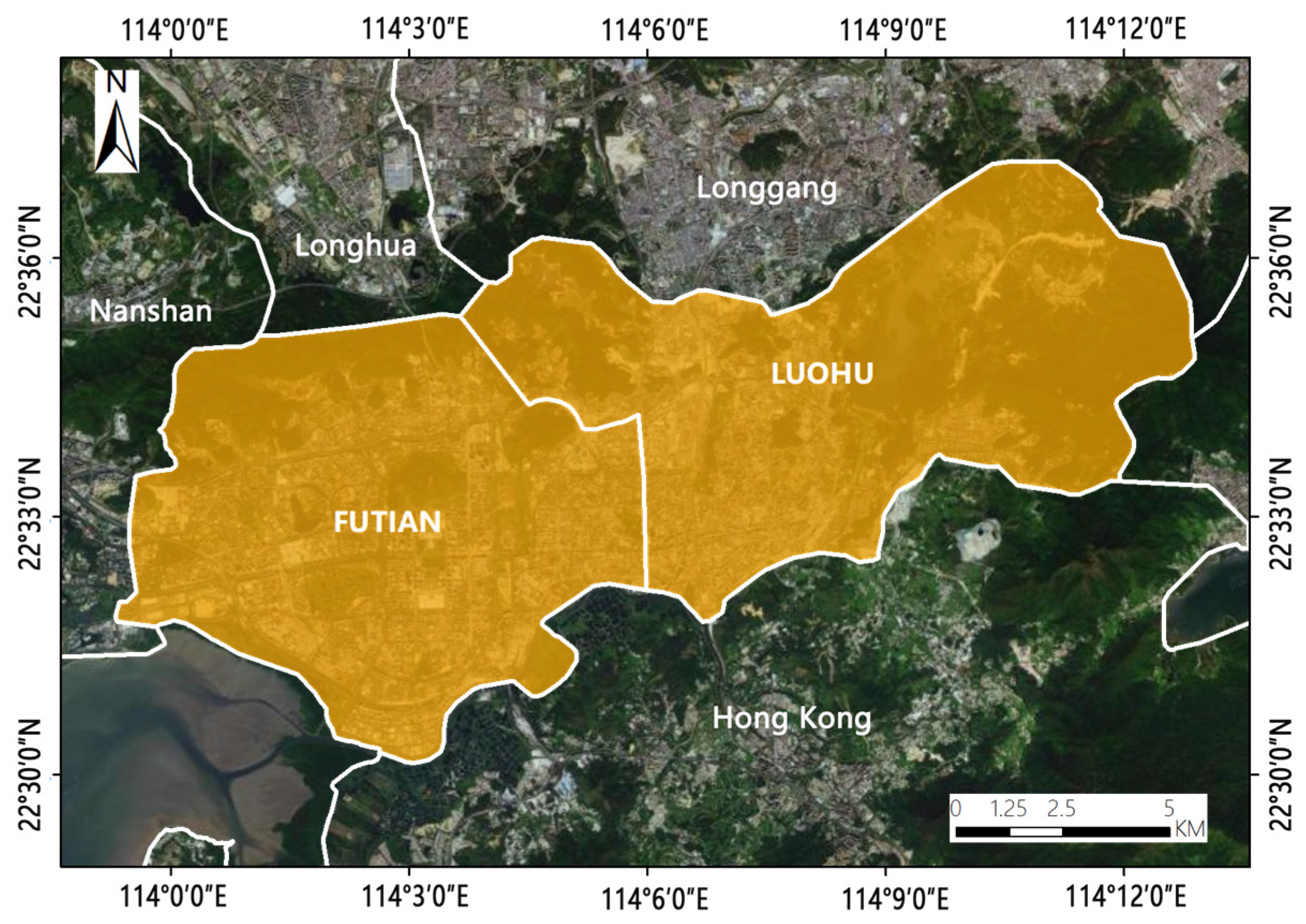




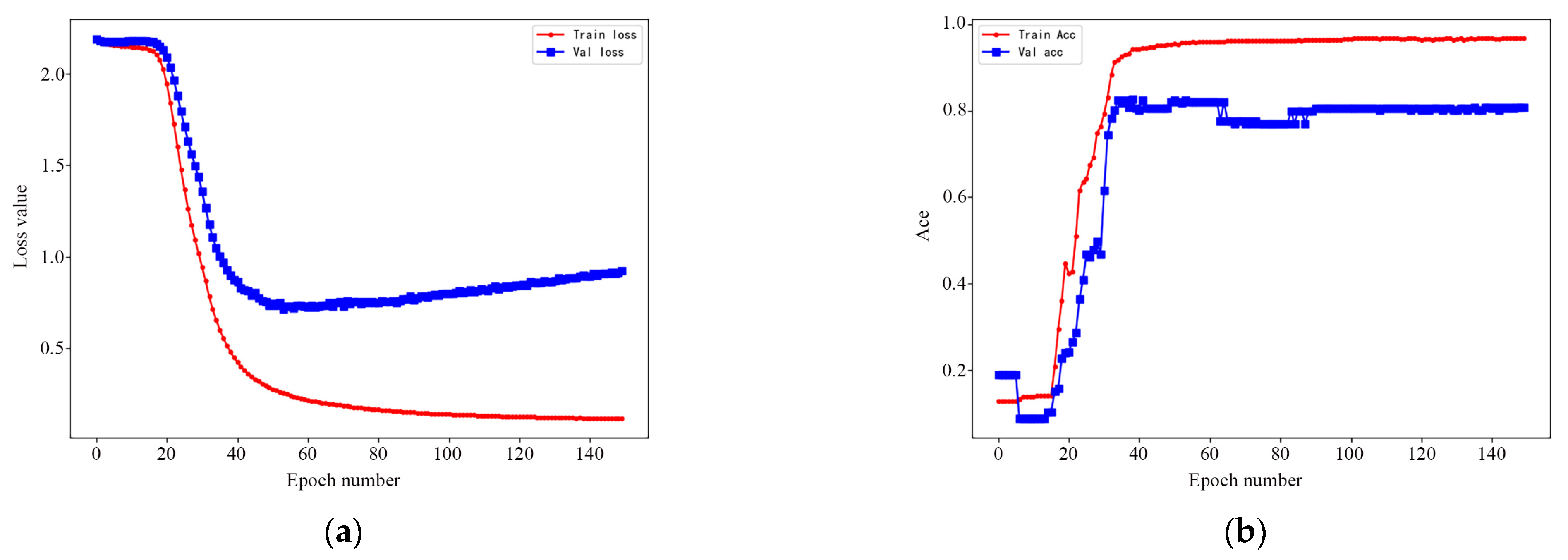
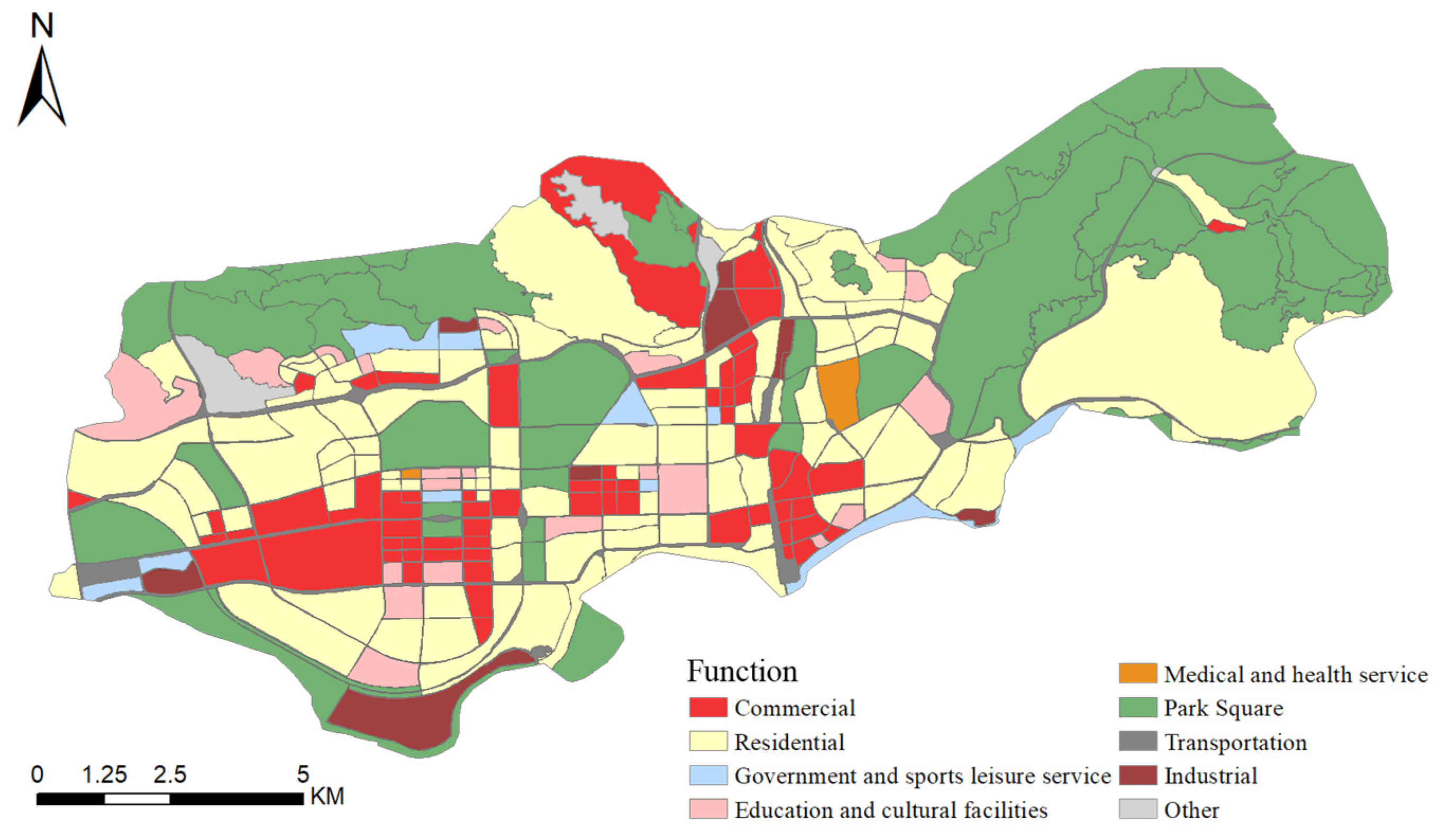
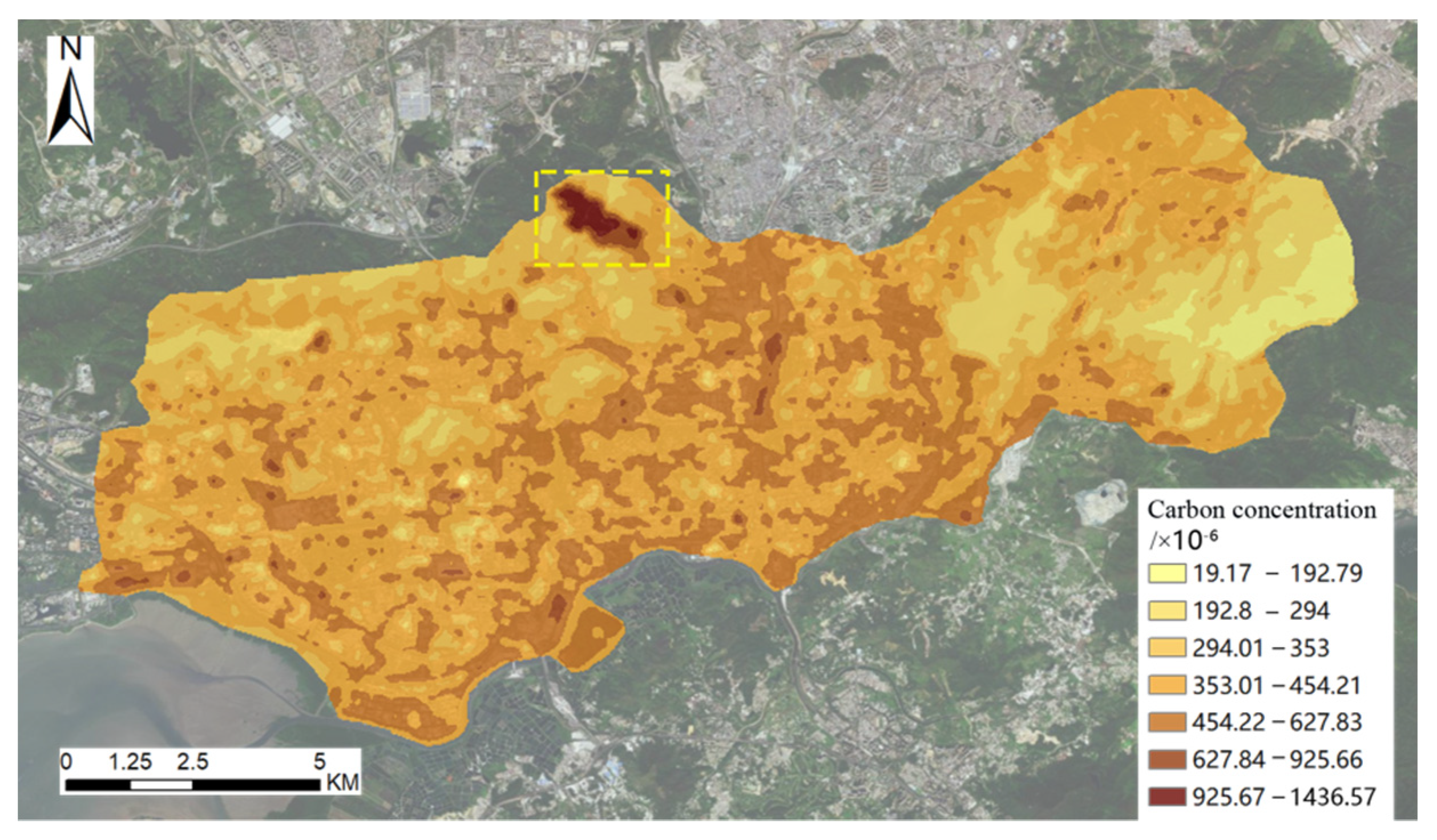
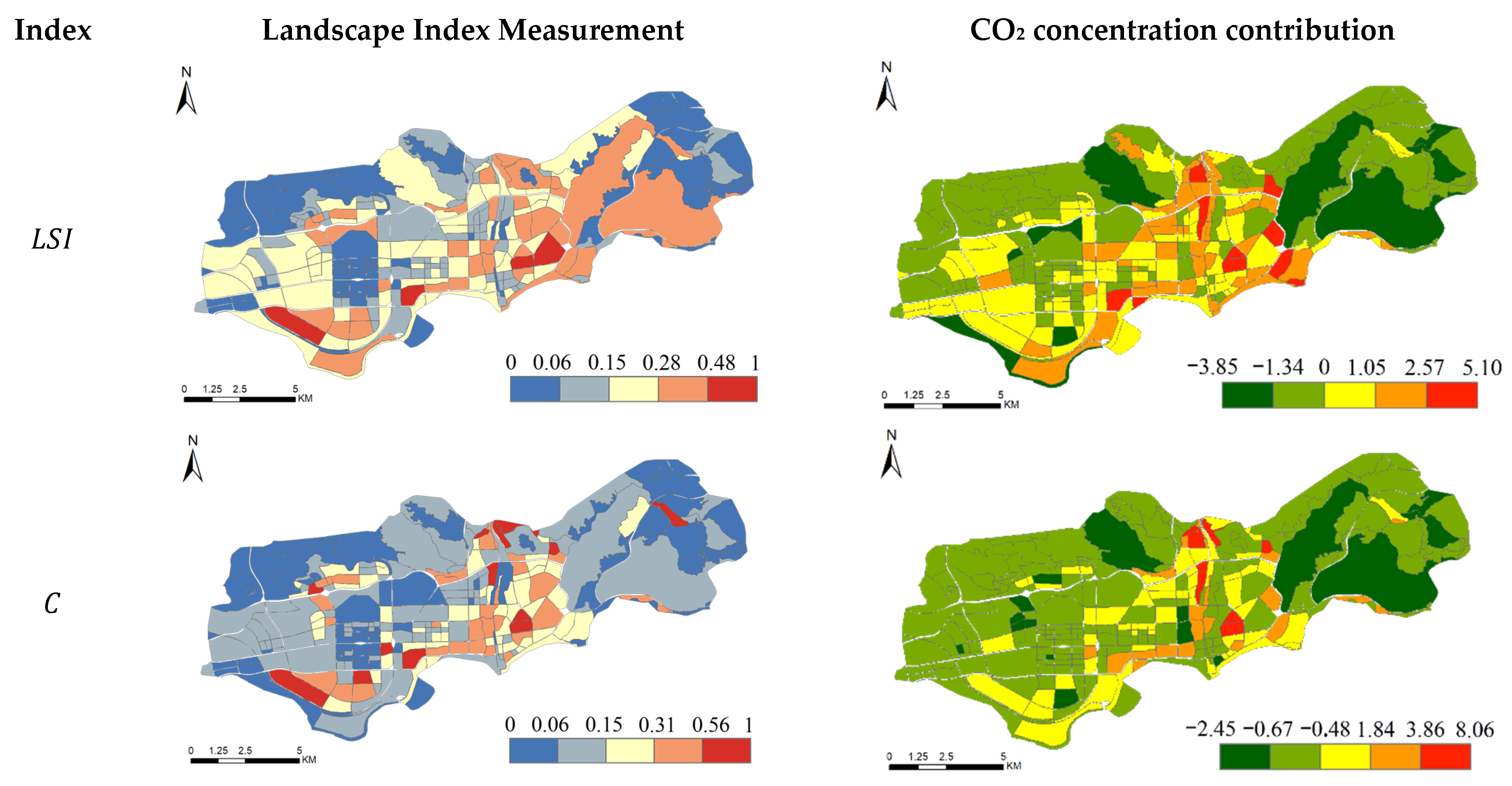
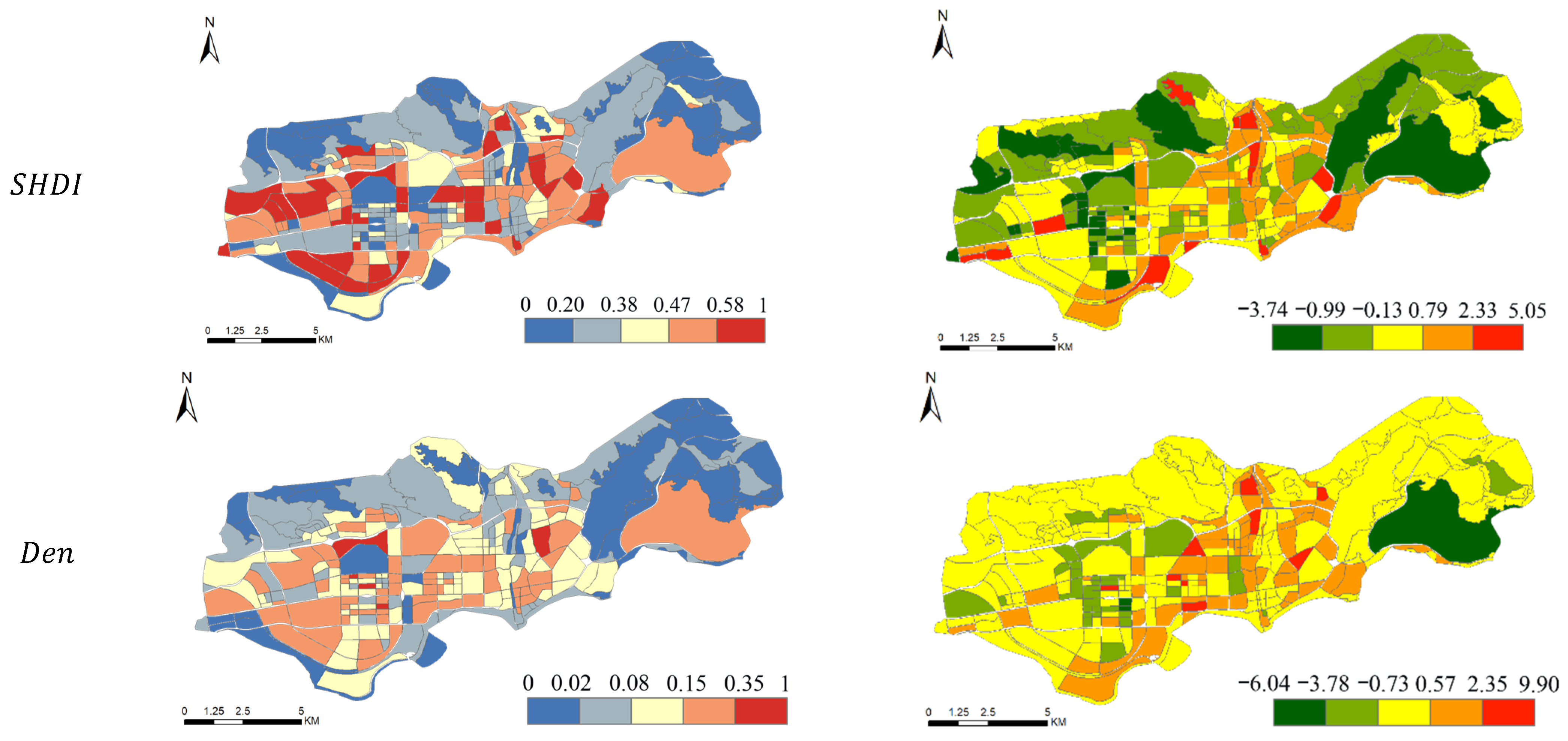



| Type of Data | Data Sources | Data Usage | Time of Data |
|---|---|---|---|
| POIs data | https://lbs.amap.com/ (accessed on 1 January 2022) | Dominant function identification and landscape index calculation | 2022 |
| OpenStreetMap | https://www.openhistoricalmap.org/ (accessed on 1 January 2022) | Division of evaluation parcels | 2022 |
| Landsat-8 image | https://www.nasa.gov/ (accessed on 20 February 2021) | CO2 concentration calculation | 2021 |
| Function Type | Corresponding POI Classification |
|---|---|
| Commercial | Restaurant, cafe, bar, tea house, hotel, cinema, shopping mall, shopping center, wholesale market, monopoly store, supermarket, convenience store, home building materials store, digital appliance, market, shop, beauty salon, barbershop, manicure, resort, KTV, theater, dance hall, internet bar, playground, bathing and massage, leisure plaza, company, bank, insurance, business hall, training institution, bookstore, gas station, driving school (registration offices), pet hospital, printing shop |
| Residential | Residence, apartment, dormitory, villa |
| Government and sports leisure service | Government, fire department, police station, court, industry and commerce bureau, tax bureau, finance bureau, customs, embassy, association, foundation, welfare institution, stadium, swimming pool, basketball court, badminton court |
| Education and cultural facilities | Kindergarten, nursery school, primary school, middle school, high school, university, adult education, vocational school, special education school, private school, scientific research institution, museum, library, conference center |
| Medical and health service | Hospital, children’s hospital, clinic, emergency center, psychiatric hospital, infectious disease hospital, tuberculosis, eye hospital |
| Park Square | Park, green space, botanical garden, water |
| Transportation | Bus station, high-speed train station, railway station, subway station, driving school (training field) |
| Industrial | Factory, processing plant, logistics, warehousing, water purification plants |
| Other | Graveyard, public toilet, parking lot, water supply, electricity, garbage disposal site, temple |
| Landscape Index | Calculation Formula | Description |
|---|---|---|
| Landscape Shape Index | It reflects the fractal dimension and morphological characteristics of urban landscape elements. | |
| Fragmentation Index | It reflects the degree of fragmentation of landscape elements | |
| Shannon’s Diversity Index | It reflects the diversity of urban public facilities. | |
| Density of Public Facilities | It reflects the density of urban public facilities. |
| ID | Type | POI Number | Weight | Number of Functional Parcels | Functional Parcel Area/km2 |
|---|---|---|---|---|---|
| 1 | Commercial | 194,970 | 1.834312 | 65 | 17.4 |
| 2 | Residential | 25,569 | 1.640193 | 100 | 55.27 |
| 3 | Government and sports leisure service | 5811 | 2.648612 | 10 | 3.13 |
| 4 | Education and cultural facilities | 7506 | 2.438533 | 21 | 6.81 |
| 5 | Medical and health service | 2710 | 2.461524 | 2 | 0.81 |
| 6 | Park Square | 971 | 2.158362 | 67 | 54.43 |
| 7 | Transportation | 5841 | 2.306906 | 8 | 16.78 |
| 8 | Industrial | 4234 | 1.539243 | 10 | 3.91 |
| 9 | Other | 1254 | 2.153471 | 4 | 2.47 |
Publisher’s Note: MDPI stays neutral with regard to jurisdictional claims in published maps and institutional affiliations. |
© 2022 by the authors. Licensee MDPI, Basel, Switzerland. This article is an open access article distributed under the terms and conditions of the Creative Commons Attribution (CC BY) license (https://creativecommons.org/licenses/by/4.0/).
Share and Cite
Cao, F.; Qiu, Y.; Wang, Q.; Zou, Y. Urban Form and Function Optimization for Reducing Carbon Emissions Based on Crowd-Sourced Spatio-Temporal Data. Int. J. Environ. Res. Public Health 2022, 19, 10805. https://doi.org/10.3390/ijerph191710805
Cao F, Qiu Y, Wang Q, Zou Y. Urban Form and Function Optimization for Reducing Carbon Emissions Based on Crowd-Sourced Spatio-Temporal Data. International Journal of Environmental Research and Public Health. 2022; 19(17):10805. https://doi.org/10.3390/ijerph191710805
Chicago/Turabian StyleCao, Fangjie, Yun Qiu, Qianxin Wang, and Yan Zou. 2022. "Urban Form and Function Optimization for Reducing Carbon Emissions Based on Crowd-Sourced Spatio-Temporal Data" International Journal of Environmental Research and Public Health 19, no. 17: 10805. https://doi.org/10.3390/ijerph191710805
APA StyleCao, F., Qiu, Y., Wang, Q., & Zou, Y. (2022). Urban Form and Function Optimization for Reducing Carbon Emissions Based on Crowd-Sourced Spatio-Temporal Data. International Journal of Environmental Research and Public Health, 19(17), 10805. https://doi.org/10.3390/ijerph191710805








